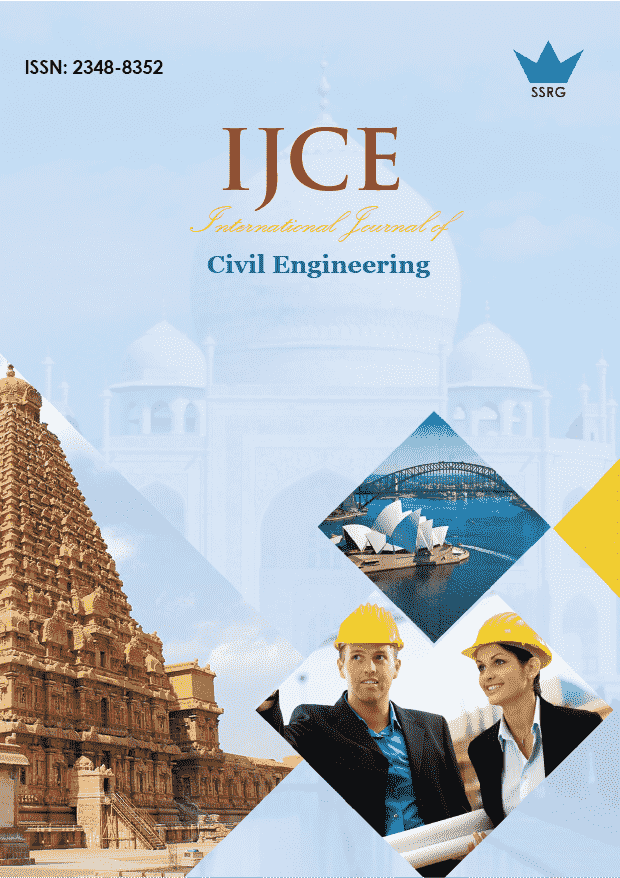Mechanical Properties of Recycled Coarse Aggregate Concrete with Mineral Admixture

| International Journal of Civil Engineering |
| © 2019 by SSRG - IJCE Journal |
| Volume 6 Issue 2 |
| Year of Publication : 2019 |
| Authors : A.V.Pramod, Prakash Parashivamurthy, M.R.Yoganada, Srishaila J M |
How to Cite?
A.V.Pramod, Prakash Parashivamurthy, M.R.Yoganada, Srishaila J M, "Mechanical Properties of Recycled Coarse Aggregate Concrete with Mineral Admixture," SSRG International Journal of Civil Engineering, vol. 6, no. 2, pp. 4-12, 2019. Crossref, https://doi.org/10.14445/23488352/IJCE-V6I2P102
Abstract:
The most abundantly used construction material in the world is concrete. The basic materials used in the production of concrete are mined extensively, which has created a lot of pressure on the environment, leading to depleting these materials' natural sources. This creates a situation where alternate materials are being looked at, producing concrete that creates a minimum impact on the environment. This paper discusses M25 grade concrete's mechanical properties made with recycled coarse aggregate using mineral admixtures such as fly ash, GGBS, and combination. By utilizing the recycled coarse aggregate and mineral admixtures, the demand on the environment is reduced to a greater extent. This shows the direction towards making the concrete more sustainable and greener. M25 grade concrete's mechanical properties such as compressive strength, split tensile strength, and flexural strength are discussed. The results are compared with that of the normal concrete produced with natural aggregates.
Keywords:
Fly ash, GGBS, Recycled coarse aggregate, Compressive strength, flexural strength, Split tensile strength.
References:
[1] M.L.Brendt., Properties of sustainable concrete containing fly ash, slag, and recycled concrete aggregate, Construction, and Building Materials, 23 (7),(2009) ,2606 – 2613.
[2] Ozkan Sengul, Mehmet Ali Tasdemir., Compressive strength and rapid chloride permeability of concretes with ground fly
ash and slag, Journal of Materials in Civil Engineering, 21(9), (2009).
[3] Patrick L Maier, Stephen A Durham, Beneficial use of recycled materials in concrete mixtures, Construction and Building Materials, 29,(2012),428 - 437.
[4] Weerachart Tangchirapat, Chaiyanunt Rattanashotinunt, Rak Buranasing, Chai Jaturapitakkul, Influence of fly ash on slump loss and strength concrete fully incorporating recycled concrete aggregates, Journal of Materials in Civil Engineering., 25(2),(2013).
[5] Ahmed. S.F.U, Properties of concrete containing construction and demolition wastes and fly ash, Journal of Materials in Civil Engineering., 25(12), (2013).
[6] Ilker Bekir Topcu, Selim Sengel, Properties of concretes produced with waste concrete aggregate, Cement and concrete research, 34(8),(2004),1307 – 1312.
[7] Shi-cong Kou, Chi-sun-Poon., Francisco Agrela, Comparisons of natural and recycled aggregate concrete prepared with different mineral admixtures, Cement and concrete composites., 33(8),(2011),788 – 795.
[8] Rattapon Somna., Chai Jaturapitakkul, Wichian Chalee, Pokpong Rattanachu, Effect of the water to binder ratio and ground fly ash on properties of recycled aggregate concrete, Journal of Materials in Civil Engineering., 24(1),(2012).
[9] Khaldoun Rahal., Mechanical properties of concrete with recycled coarse aggregate, 42 (1),(2007),407 – 415.
[10] A.K.Mullick., Green options for binder system and aggregate in sustainable concrete, The Indian Concrete Journal, (2012), 9- 17.
[11] Hawra Alradhawi Reinforcing Smart Home Security System, International Journal of Engineering Trends and Technology (IJETT), 57(1) (2018) 32-39.

 10.14445/23488352/IJCE-V6I2P102
10.14445/23488352/IJCE-V6I2P102